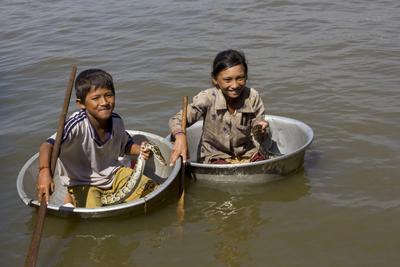Muddy Waters to Reveal Secrets of the Asian Monsoon
A team of researchers from Geography & Environment, University of Southampton, have been awarded the Gilchrist Educational Trust (in conjunction with the Royal Geographical Society with IBG) Fieldwork Award for their project: "Mud, Monsoons and the Mekong: A 5000 Year Record of the Asian Monsoon and Mekong River Flood Regime from Tonle Sap Lake Sediments"

The team, led by Professor Steve Darby, and which includes Dr Pete Langdon and Dr Julian Leyland, will in spring 2013 be undertaking a major fieldwork expedition to South East Asia’s largest and most important freshwater lake: the Tonle Sap in central Cambodia. The Tonle Sap is believed to have become connected to the Mekong River between 5000-8000 years ago. Since then sediments eroded from the Mekong Basin have been flushed into the lake during the monsoon flood, where they eventually are deposited. The team will map the lake sediments and bathymetry in detail and retrieve cores of this accumulated sediment from the lake's deepest areas. The team will also travel to remote headwater regions to take samples of the sediments emanating from the major tributaries that feed the Mekong.
The physical and chemical characteristics of the sediments deposited contain clues that, when combined with a suite of sophisticated dating techniques to determinetheir age, will enable the team to reconstruct past variations in Mekong River flooding.
Such changes are ultimately driven by changes in the intensity of the Asian monsoon. Furthermore, by matching the characteristics of the lake sediments to the distinctive geological characteristics of the regions crossed by the Mekong's tributaries, the researchers will also be able to trace the deposited materials back to their sources: the Khorat Plateau of central Thailand, the tropical forests of the Annamite Mountains in Laos and Vietnam, or the steep slopes of Yunnan and Tibet. The team hope this sediment tracing will reveal past changes in the dynamics of the monsoon circulation. Analysis of microscopic fossils contained within the lake sediments will also help the team understand how the Tonle Sap's ecosystem has developed and responded to shifts in the Mekong's hydroclimate.
Dr Leyland said, "By analysing how past variations in monsoon intensity have affected flooding we will be better able to understand how future climate changes may affect flood risk on the Mekong." Dr Langdon added, "The Tonle Sap is southeast Asia's most important freshwater fishery, and 3 million people are dependent on the lake for their main source of protein. This award will help us to understand how regional food security may be affected by hydrological change." Professor Darby went on, "We are delighted to receive this award, which is very timely. In the next 20 years there are plans to construct numerous hydropower dams on the Mekong and its tributaries. The effects of these dams on the Mekong's hydrology may be analogous to 'mega-droughts' that are known to have occurred when the monsoon has failed in the past. The past may therefore be the key to understanding how future environmental change may affect the 20 million people who live on the banks of the Mekong and depend on it for their livelihoods."
